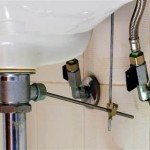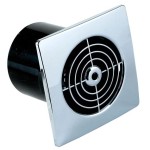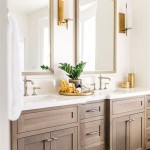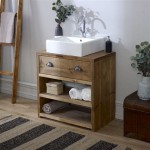Here's an article on painting bathroom countertops, formatted as requested:
Can You Paint Your Bathroom Countertop? A Comprehensive Guide
Painting bathroom countertops presents a potentially cost-effective and aesthetically pleasing method for updating the appearance of a bathroom without undertaking a full-scale renovation. However, the success and longevity of a painted countertop hinge on meticulous preparation, careful product selection, and diligent application. This article will explore the possibilities and limitations of painting bathroom countertops, providing a detailed overview of the process and considerations involved.
The primary appeal of painting a bathroom countertop lies in its affordability. Replacing a countertop, especially with materials like granite or quartz, can be a significant expense. Painting, by contrast, offers a budget-friendly alternative that can drastically change the look of a bathroom. Furthermore, painting provides a high degree of customization. A wide array of colors, finishes, and decorative techniques can be employed to achieve a desired aesthetic, allowing homeowners to personalize their space according to their preferences.
Despite the advantages, painting a bathroom countertop is not without its drawbacks. Bathroom countertops are subjected to frequent exposure to moisture, cleaning agents, and physical wear and tear. Conventional paints are often not designed to withstand such conditions, leading to chipping, peeling, and water damage. Therefore, selecting the appropriate paint and sealant is crucial to ensure the durability and longevity of the painted surface. The preparation process is also paramount; improper preparation can lead to adhesion problems and premature failure of the paint job.
Key Point 1: Surface Preparation is Paramount
Proper surface preparation is arguably the most critical factor in determining the success of painting a bathroom countertop. The existing surface must be thoroughly cleaned, sanded, and primed to ensure adequate adhesion of the paint. Failure to adequately prepare the surface can result in paint peeling, chipping, or bubbling, significantly shortening the lifespan of the painted countertop.
The first step in surface preparation is a thorough cleaning. Remove all items from the countertop and use a degreasing cleaner to remove any soap scum, dirt, or grime. Rinse the surface thoroughly with clean water and allow it to dry completely. This step is crucial for removing contaminants that could interfere with paint adhesion.
Sanding is the next essential step. The purpose of sanding is to create a slightly rough surface that provides a better grip for the primer and paint. The appropriate grit of sandpaper will depend on the existing countertop material. For laminate countertops, a medium-grit sandpaper (around 120-150 grit) is typically sufficient. For smoother surfaces like tile or cultured marble, a coarser grit (around 80 grit) may be required initially, followed by a medium grit to smooth out the scratches. Sand the entire surface evenly, paying particular attention to edges and corners. After sanding, thoroughly remove all sanding dust with a tack cloth or a damp cloth.
Priming is the final step in surface preparation. A high-quality primer is essential for promoting adhesion and preventing the existing surface from bleeding through the paint. Choose a primer specifically designed for the type of countertop material being painted. For example, an epoxy primer is often recommended for laminate countertops, while a stain-blocking primer is suitable for surfaces that may have stains or discoloration. Apply the primer in thin, even coats, following the manufacturer's instructions. Allow the primer to dry completely before proceeding to the next step.
Key Point 2: Selecting the Right Paint and Sealant
The choice of paint and sealant is equally important to surface preparation. Not all paints are created equal, and selecting a product that is specifically formulated for use on countertops and in damp environments is crucial for achieving a durable and long-lasting finish. Several types of paint and sealant are suitable for bathroom countertops, each with its own advantages and disadvantages.
Epoxy paint is often considered one of the best options for painting bathroom countertops. Epoxy paints are known for their exceptional durability, water resistance, and resistance to chemicals and stains. They form a hard, non-porous surface that is easy to clean and maintain. However, epoxy paints can be more difficult to apply than other types of paint, and they often require specialized equipment and techniques. They also tend to have a strong odor during application, so proper ventilation is essential.
Acrylic polyurethane paint is another viable option for bathroom countertops. Acrylic polyurethane paints are durable, water-resistant, and relatively easy to apply. They are also available in a wide range of colors and finishes. However, they are not as durable as epoxy paints and may be more susceptible to scratches and stains. When using acrylic polyurethane paint, it is essential to apply several coats to achieve adequate protection.
Chalk paint can also be used on bathroom countertops, but it requires a durable sealant to protect it from moisture and wear. Chalk paint is known for its matte finish and its ability to adhere to a variety of surfaces without extensive priming. However, it is porous and not inherently water-resistant. Therefore, it must be sealed with several coats of a high-quality sealant, such as polyurethane or epoxy resin. The sealant will provide the necessary protection against water damage and stains.
Regardless of the type of paint chosen, a high-quality sealant is essential for protecting the painted surface. The sealant should be specifically designed for use in wet environments and should be resistant to water, chemicals, and scratches. Apply several thin coats of sealant, allowing each coat to dry completely before applying the next. Pay particular attention to edges and corners, as these areas are more prone to water damage.
Key Point 3: Application Techniques and Considerations
The proper application of paint and sealant is crucial for achieving a professional-looking and durable finish. Several techniques and considerations should be taken into account when painting a bathroom countertop.
Before beginning the painting process, protect the surrounding areas with painter's tape and drop cloths. This will prevent paint from getting on walls, cabinets, and fixtures. Ensure that the bathroom is well-ventilated to allow the paint fumes to dissipate.
Apply the paint in thin, even coats, using a high-quality brush or roller. Avoid applying too much paint at once, as this can lead to drips and runs. Allow each coat to dry completely before applying the next. Multiple thin coats are always better than one thick coat.
When using a brush, use long, smooth strokes to avoid leaving brush marks. When using a roller, use a light touch to avoid creating a textured surface. Overlap each stroke slightly to ensure complete coverage.
Pay particular attention to edges and corners, as these areas are often difficult to paint evenly. Use a small brush to carefully paint these areas, ensuring that the paint is applied smoothly and evenly.
After applying the paint, allow it to dry completely before applying the sealant. Follow the manufacturer's instructions for drying times. Once the paint is dry, carefully inspect the surface for any imperfections. If necessary, lightly sand any rough spots and apply another coat of paint.
Apply the sealant in the same manner as the paint, using thin, even coats. Allow each coat to dry completely before applying the next. Several coats of sealant are necessary to provide adequate protection against water damage and stains. Pay particular attention to edges and corners.
After applying the final coat of sealant, allow it to cure completely before using the countertop. Curing times can vary depending on the type of sealant used, so it is important to follow the manufacturer's instructions. Avoid placing heavy objects on the countertop during the curing process.
Maintaining a painted bathroom countertop requires regular cleaning and care. Avoid using abrasive cleaners or harsh chemicals, as these can damage the painted surface. Use a mild soap and water to clean the countertop regularly. Wipe up spills immediately to prevent staining. Consider using placemats or coasters to protect the countertop from scratches and heat damage.
In conclusion, while painting a bathroom countertop can be a viable option for updating the appearance of a bathroom on a budget, it requires careful planning, meticulous preparation, and the use of appropriate materials. By following the steps outlined in this article, individuals can increase the likelihood of achieving a durable and aesthetically pleasing painted countertop that will enhance the look of their bathroom for years to come.

Paint Bathroom Vanity Countertop Sink So Easy A Piece Of Rainbow
:strip_icc()/101922779-2cbc45e123c34827afb4f601723b03ca.jpg?strip=all)
How To Paint Bathroom Countertops

Should You Be Painting Your Bathroom Countertops Caesarstone

Paint Bathroom Vanity Countertop Sink So Easy A Piece Of Rainbow

How To Paint A Countertop Don T Make These Mistakes Blessed Beyond Crazy

How To Paint A Countertop Don T Make These Mistakes Blessed Beyond Crazy

How To Paint Tile Countertops And Our Modern Bathroom Reveal Bright Green Door

How To Paint Tile Countertops And Our Modern Bathroom Reveal Bright Green Door

Can I Paint My Bathroom Countertop Badeloft
.gif?strip=all)
Painting A Bathroom Vanity Again Dream Green Diy
Related Posts







